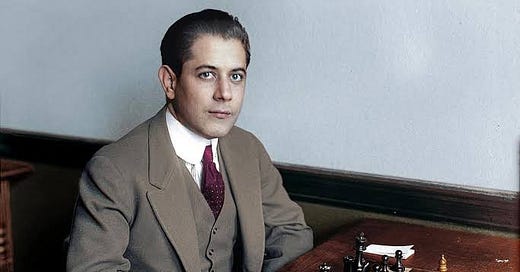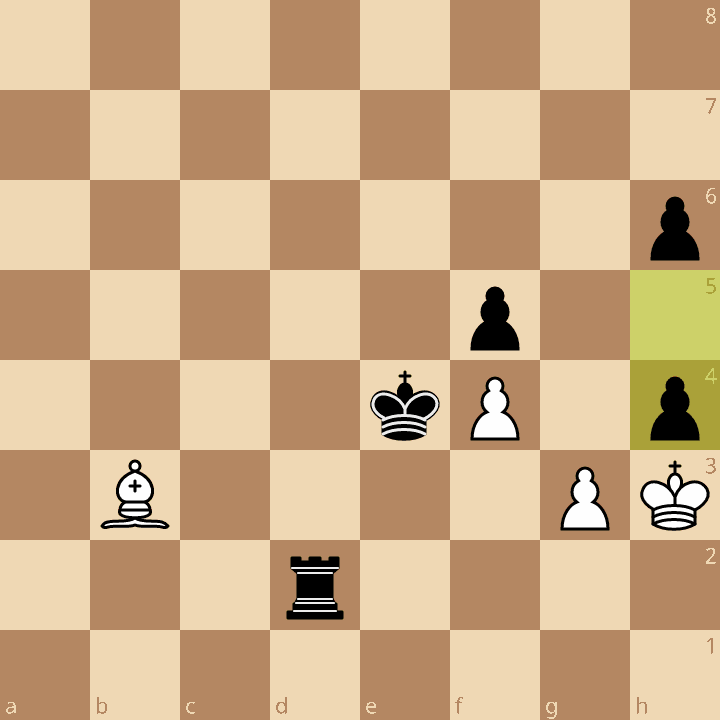The hardest thing in chess is winning a won game. All of us have had the experience of obtaining some advantage that should be winning and then watching it eventually dwindle away into nothing. But in today’s game, the great Capablanca is here to show us the way. Relatively early in the middlegame, he wins an exchange against Frank Marshall. He then methodically and carefully trades down material until that advantage becomes overwhelming.
If you did your homework way back when I first posted it, you’ve already gone through the game a few times and drafted a plain-language summary of what happened. (If you haven’t done that yet, do it before proceeding.)
As you go through the following positions, pay particular attention to the placement of both sides’ pieces and pawns and, especially, what’s going on with the light squares. This game shows that superficial views of “good” versus “bad” bishops can lead to disaster.
Also be on the lookout for some classy and instructive moves whose purposes aren’t obvious at first. Whenever you encounter one of these in a classic game, you should strive to figure out what the master was trying to accomplish without the aid of a computer. If you’re struggling to do so, here are a couple hints that might kickstart your thinking:
First, when you see a mysterious move, ask yourself if the opponent is threatening something. Then examine what happens if he carries out that threat following the mysterious move. You may discover that the mysterious move prevents the original threat tactically.
Second, if you see no obvious tactical benefit to the move, step out of the tactical mindset and look at the move positionally: Does the move improve the position of a piece or force the opponent to worsen the position of one of his pieces?
Now, on to the positions:
Position 1:
The Lasker defense to the Queens Gambit Declined arises after 1. d4 d5, 2. c4 e6, 3. Nc3 Nf6, 4. Bg5 Be7, 5. e6 Ne4. Though never extraordinarily popular, it was played repeatedly in this match (and Lasker debuted it in an earlier match against Marshall). This unbalanced position arose after the continuation 6. Bxe7 Qxe7, 7. cxd5 Nxc3, 8. bxc3 exd5.
What are the strengths and weaknesses of both side’s positions?
What are the early plans for both sides? Where do they want to put their pieces? What challenges will they have to overcome?
Position 2:
White has just played 16. Ra4. We’ve seen in previous games that the decision to disconnect your rooks can be extremely consequential. What are the dangers of this move?
Take a moment and examine the coordination of White’s pieces and Black’s pieces. Whose do you prefer and why?
What color squares are White’s and Black’s pieces and pawns on? How does this contribute to the tactical risks in the position?
Position 3:
Why is 17. Qa3 a blunder? What observations did you make in the previous position that might have warned Marshall off of playing this move?
What would have been a better move for White?
Position 4:
Black is up an exchange. What is his strategic goal now?
What logical moves advance that goal?
Position 5:
Black has succeeded in trading down the pieces. Now it’s a matter of further simplifying the position and converting the endgame. But checkmate ends the game whenever it comes. What move by White would be a blunder here?
How does White eliminate that threat?
Position 6:
Capablanca has just played 35….Qe7, removing a defender from the twice-attacked c4 pawn. Has he blundered the pawn?
Position 7:
Can Capablanca win White’s bishop with 38…Qc5 or 38...Qc7? Why or why not?
What can Capablanca accomplish with 38…Qc5 or 38...Qc7, and is that desirable?
Instead of either of these moves, Capablanca played 38…Qb7+, followed by 39…Qb6. What is the purpose of Qb7+?
Position 8:
In this position, following Black’s 49th move, White resigned. Why? Does Capablanca have a forced mate? How might the rest of the game have played out?
Next Steps:
After you’ve thought through these questions, revisit your factual brief to see if there are material facts you omitted. Update it accordingly.
There’s no need to post all your answers (though you can if you want to). The primary value here is that you practice thinking rigorously about chess positions. But if there are particular answers you’re unsure about, definitely feel free to put them in the comments and we can try to figure it out.
Finally, if you learned something from this game (or two or three things) write it in the comments below!












